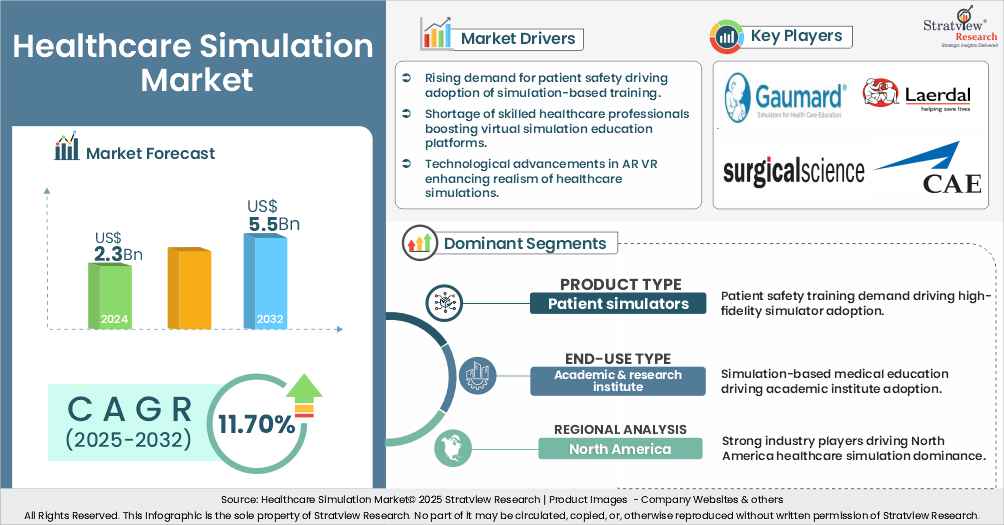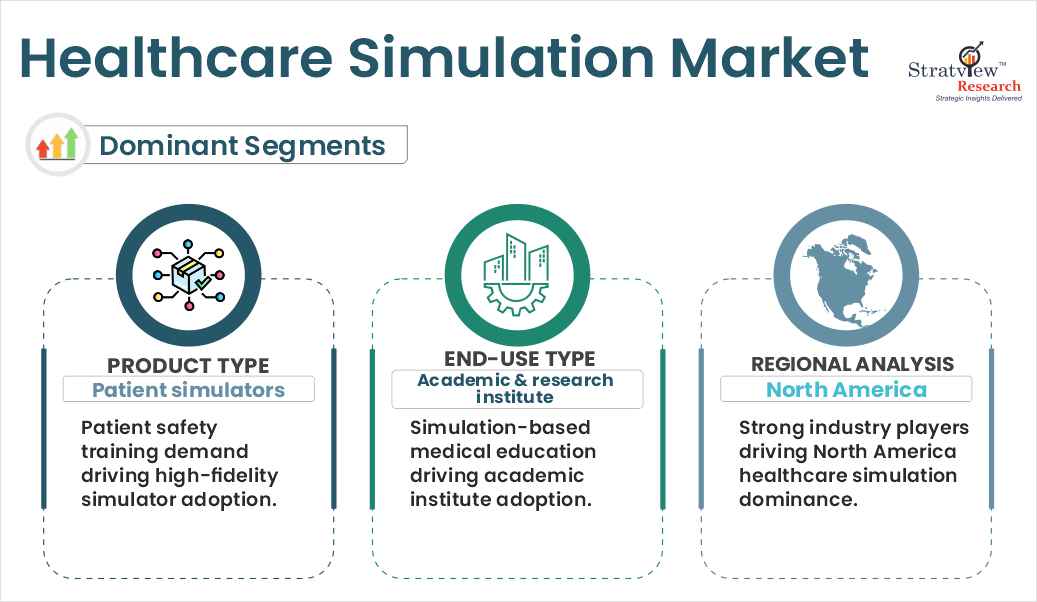Healthcare Simulation Market Insights
"The global healthcare simulation market was valued at US$ 2.3 billion in 2024 and is projected to reach US$ 5.5 billion by 2032, registering a CAGR of 11.70% during the forecast period."

Want to get a free sample? Register Here
Introduction
Healthcare simulation is a modern way to train healthcare professionals through the use of cutting-edge educational technology. It's an artificial model that encompasses different man-made models to attain educational objectives through hands-on learning. The propelling factors for the market growth of healthcare simulation include continuous technological advancements, increasing concerns over patient safety, and increasing demand for minimally invasive treatments.
Healthcare Simulation Market Drivers
- Rising Demand for Patient Safety and Error Reduction.
- Growing Adoption of Virtual and Augmented Reality.
- Increasing Use of AI and Data Analytics.
- Expanding Medical Education and Training Programs.
- Supportive Government Initiatives and Investments.
|
Healthcare Simulation Market Scope
|
|
Market Size in 2032
|
USD 5.5 billion
|
|
Market Size in 2024
|
USD 2.3 billion
|
|
CAGR (2021-2026)
|
11.70%
|
|
Base Year of Study
|
2024
|
|
Trend Period
|
2019-2023
|
|
Forecast Period
|
2025-2032
|
Healthcare Simulation Market Trends
The World Health Organization reports that the problem of patient harm is one of the numerous problems in healthcare.
According to the WHO, it is estimated that every year tens of millions of patients are injured or even killed by unsafe health care. Related medical practices and hazards of safe healthcare are significant threats to patient safety and add to the injury caused by unsafe care. Below are some of the major threats to patient safety.
Medication errors are also a leading cause of injury and preventable harm to human beings in healthcare service systems, with a potential annual burden of US$42 billion worldwide.
The impact of healthcare-associated infections on patients in high-income countries shows that 7 of every 100 patients are hospitalized within a year of their hospitalization, while in low- and middle-income countries this figure stands at 10 of every 100 patients.
Infections following unsafe surgical practices can affect one-fourth of the patients. This corresponds to nearly 7 million surgical patients with a major complication each year and more than 1 million surgical deaths.
Unsafe injection practices in healthcare settings not only put patients and healthcare workers at risk of secondary injection exposures but also contribute to the continued transmission of HIV and hepatitis B and C. These practices account for approximately 9% of infections. Disease and disability burden worldwide in terms of Disability Adjusted Life Years (DALYs) is equivalent to 2 million years lost.
Five percent of adults seeking outpatient care also experienced diagnostic errors, and more than half of these errors had the potential to cause serious harm. Data indicate that most patients will suffer from diagnostic errors in the course of their lives.
This is why unsafe transfusion practices endanger patients’ lives by exposing them to the risks of adverse transfusion reactions and infections. In data from 21 countries in all regions of the world, 8% of serious adverse transfusion reactions were reported, 7 per 100,000 distributed blood components on average.
Radiation errors may take several forms, ranging from overexposure to radiation to the wrong patient or treatment site. Based on the review of safety data from 30 years of practice in radiotherapy, the number of preventable errors per 10,000 treatment courses is estimated to be around 15.
Sepsis is a condition that is potentially life-threatening, and therefore proper identification of this condition in its early stages is of great importance. Sepsis infections are sometimes immune to antibiotics at times which causes a rapid deterioration in clinical conditions. Unfortunately, this condition is one of the most fatal in the world affects over 31 million people worldwide, and causes over 5 million deaths each year.
Venous thromboembolism represents a preventable source of patient harm that accounts for one-third of hospital-acquired conditions. Economic countries are expected to account for 3.9 million cases per year, with as many as 6 million cases reported in low- and middle-income countries.
Segments' Analysis
|
Segmentations
|
List of Sub-Segments
|
Dominant and Fastest-Growing Segments
|
|
Product -Type
|
Patient Simulator [Low Fidelity, Medium Fidelity, and High Fidelity], Surgical Simulator [Technology-Based, Web-Based, and Computer-Based], and Ultrasound Simulator [Technology-Based, Web-Based, and Computer-Based]
|
Patient simulators occupied the major market share.
|
|
End-Use -Type
|
Academic & Research Institute, Hospitals, and Ambulances
|
Academic & Research Institute owned the major market share.
|
|
Regional Analysis
|
North America, Europe, Asia-Pacific, and the Rest of the World)
|
North America is expected to remain the largest market share.
|
Product Trends
"Patient simulators accounted for the largest market share."
The market has been segmented as patient simulators, surgical simulators, and ultrasound simulators. Patient simulators are further segmented as high-fidelity, medium-fidelity, and low-fidelity patient simulators. Patient simulators occupied a major market share of more than 65% in 2024, followed by surgical simulators and ultrasound simulators.
Both surgical and ultrasound simulators are further segmented into technology-based, web-based, and computer-based simulators. Among these additional classifications of simulators, the technology-based surgical and ultrasound simulators accounted for the dominant market shares.
End-Use Trends
"The academic & research institute segment accounted for the largest market share."
The market is segmented by hospitals, academic & research institutes, and ambulances. Among these segments, the academic & research institute segment owned the major market share of more than 70% in 2024, followed by hospitals and ambulances.
Regional Insights
"North America accounted for the largest market share."
North America is expected to remain the largest market share for healthcare simulation and it held a revenue share of more than 50% in 2024. This region has the presence of a large number of major players such as CAE Inc., Laerdal Medical, Gaumard Scientific Company, and Nasco HealthCare, making the region the growth engine of the global healthcare simulation market. Most of the healthcare simulation providers have their presence in the region to address the requirements of the academic & research institutes and hospitals. Europe and Asia-Pacific are also likely to create sizeable opportunities in the coming five years, driven by an expected rebound in healthcare simulator demand coupled with a paradigm shift from medical mannequins to high-fidelity simulators.
Latin America is expected to witness significant growth in the healthcare simulation market due to the increasing demand for advanced healthcare technologies and the growing need to improve patient safety. Brazil and Mexico are the major contributors to the growth of the healthcare simulation market in Latin America.
The Middle East and Africa region are also witnessing growth in the healthcare simulation market due to the increasing focus on healthcare infrastructure development, the rising demand for virtual training programs, and the growing adoption of advanced healthcare technologies. UAE, Saudi Arabia, and South Africa are the major contributors to the growth of the healthcare simulation market in the Middle East and Africa.

Want to get a free sample? Register Here
Key Players
The following are the key players in the healthcare simulation market:
Note: The above list does not necessarily include all the top players in the market.
Are you the leading player in this market? We would love to include your name. Write to us at [email protected]
Report Features
This report provides market intelligence in the most comprehensive way. The report structure has been kept such that it offers maximum business value. It provides critical insights into market dynamics and will enable strategic decision-making for existing market players as well as those willing to enter the market.
What deliverables will you get in this report?
|
Key questions this report answers
|
Relevant contents in the report
|
|
How big is the sales opportunity?
|
In-depth analysis of the Healthcare Simulation Market
|
|
How lucrative is the future?
|
Market forecast and trend data and emerging trends
|
|
Which regions offer the best sales opportunities?
|
Global, regional and country level historical data and forecasts
|
|
Which are the most attractive market segments?
|
Market segment analysis and forecast
|
|
Which are the top players and their market positioning?
|
Competitive landscape analysis, Market share analysis
|
|
How complex is the business environment?
|
Porter’s five forces analysis, PEST analysis, Life cycle analysis
|
|
What are the factors affecting the market?
|
Drivers & challenges
|
|
Will I get the information on my specific requirement?
|
10% free customization
|
Research Methodology
This strategic assessment report, from Stratview Research, provides a comprehensive analysis that reflects today’s healthcare simulation market realities and future market possibilities for the forecast period of 2025 to 2032. The report segments and analyzes the market in the most detailed manner in order to provide a panoramic view of the market. The vital data/information provided in the report can play a crucial role for market participants as well as investors in the identification of the low-hanging fruits available in the market as well as to formulate the growth strategies to expedite their growth process.
This report offers high-quality insights and is the outcome of a detailed research methodology comprising extensive secondary research, rigorous primary interviews with industry stakeholders, and validation and triangulation with Stratview Research’s internal database and statistical tools. More than 1,000 authenticated secondary sources, such as company annual reports, fact books, press releases, journals, investor presentations, white papers, patents, and articles, have been leveraged to gather the data. We conducted more than 15 detailed primary interviews with market players across the value chain in all four regions and industry experts to obtain both qualitative and quantitative insights.
Customization options
Stratview Research offers one of the following free customization options to our respectable clients:
Company Profiling
Competitive Benchmarking
Benchmarking of key players on the following parameters: Product portfolio, geographical reach, regional presence, and strategic alliances.
Custom Research: Stratview Research offers custom research services across sectors. In case of any custom research requirement related to market assessment, competitive benchmarking, sourcing and procurement, target screening, and others, please send your inquiry to [email protected]

